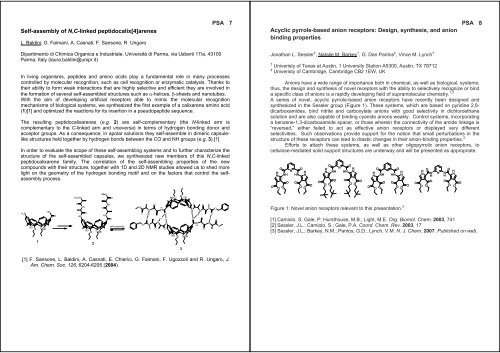ISMSC 2007 - Università degli Studi di Pavia
ISMSC 2007 - Università degli Studi di Pavia
ISMSC 2007 - Università degli Studi di Pavia
Create successful ePaper yourself
Turn your PDF publications into a flip-book with our unique Google optimized e-Paper software.
Self-assembly of N,C-linked peptidocalix[4]arenes<br />
L. Bal<strong>di</strong>ni, G. Faimani, A. Casnati, F. Sansone, R. Ungaro<br />
Dipartimento <strong>di</strong> Chimica Organica e Industriale, <strong>Università</strong> <strong>di</strong> Parma, via Usberti 17/a, 43100<br />
Parma, Italy (laura.bal<strong>di</strong>ni@unipr.it)<br />
In living organisms, peptides and amino acids play a fundamental role in many processes<br />
controlled by molecular recognition, such as cell recognition or enzymatic catalysis. Thanks to<br />
their ability to form weak interactions that are highly selective and efficient they are involved in<br />
the formation of several self-assembled structures such as -helices, -sheets and nanotubes.<br />
With the aim of developing artificial receptors able to mimic the molecular recognition<br />
mechanisms of biological systems, we synthesized the first example of a calixarene amino acid<br />
(1)[1] and optimized the reactions for its insertion in a pseudopeptide sequence.<br />
The resulting peptidocalixarenes (e.g. 2) are self-complementary (the N-linked arm is<br />
complementary to the C-linked arm and viceversa) in terms of hydrogen bon<strong>di</strong>ng donor and<br />
acceptor groups. As a consequence, in apolar solutions they self-assemble in <strong>di</strong>meric capsulelike<br />
structures held together by hydrogen bonds between the CO and NH groups (e.g. 3).[1]<br />
In order to evaluate the scope of these self-assembling systems and to further characterize the<br />
structure of the self-assembled capsules, we synthesized new members of this N,C-linked<br />
peptidocalixarene family. The correlation of the self-assembling properties of the new<br />
compounds with their structure, together with 1D and 2D NMR stu<strong>di</strong>es allowed us to shed more<br />
light on the geometry of the hydrogen bon<strong>di</strong>ng motif and on the factors that control the selfassembly<br />
process.<br />
N<br />
H 2<br />
HO<br />
O OH<br />
O<br />
1<br />
HO<br />
O<br />
CbzHN<br />
O<br />
HN<br />
NH<br />
O<br />
HO<br />
O OH<br />
O<br />
2<br />
O<br />
O<br />
HN<br />
NH<br />
O<br />
O<br />
self-assembly<br />
O<br />
O<br />
O<br />
N<br />
H<br />
O<br />
N<br />
H<br />
O<br />
O<br />
H<br />
N<br />
H<br />
N<br />
O<br />
H<br />
N<br />
O<br />
HO<br />
O<br />
O OH<br />
HO O OH O<br />
[1] F. Sansone, L. Bal<strong>di</strong>ni, A. Casnati, E. Chierici, G. Faimani, F. Ugozzoli and R. Ungaro, J.<br />
Am. Chem. Soc. 126, 6204-6205 (2004).<br />
3<br />
O<br />
N<br />
H<br />
O<br />
H<br />
N<br />
H<br />
N<br />
O<br />
O<br />
H<br />
N<br />
O<br />
H<br />
N<br />
PSA 7<br />
O<br />
O<br />
O<br />
Acyclic pyrrole-based anion receptors: Design, synthesis, and anion<br />
bin<strong>di</strong>ng properties<br />
Jonathan L. Sessler † , Natalie M. Barkey † , G. Dan Pantos ‡ , Vince M. Lynch †<br />
† Univeristy of Texas at Austin, 1 University Station A5300, Austin, TX 78712<br />
‡ Univeristy of Cambridge, Cambridge CB2 1EW, UK<br />
Anions have a wide range of importance both in chemical, as well as biological, systems;<br />
thus, the design and synthesis of novel receptors with the ability to selectively recognize or bind<br />
a specific class of anions is a rapidly developing field of supramolecular chemistry. 1,2<br />
A series of novel, acyclic pyrrole-based anion receptors have recently been designed and<br />
synthesized in the Sessler group (Figure 1). These systems, which are based on pyri<strong>di</strong>ne 2,6<strong>di</strong>carboxamides,<br />
bind nitrite and carboxylate anions with good selectivity in <strong>di</strong>chloroethane<br />
solution and are also capable of bin<strong>di</strong>ng cyanide anions weakly. Control systems, incorporating<br />
a benzene-1,3-<strong>di</strong>carboxamide spacer, or those wherein the connectivity of the amide linkage is<br />
“reversed,” either failed to act as effective anion receptors or <strong>di</strong>splayed very <strong>di</strong>fferent<br />
selectivities. Such observations provide support for the notion that small perturbations in the<br />
structure of these receptors can lead to drastic changes in their anion-bin<strong>di</strong>ng properties. 3<br />
Efforts to attach these systems, as well as other oligopyrrolic anion receptors, to<br />
cellulose-me<strong>di</strong>ated solid support structures are underway and will be presented as appropriate.<br />
O<br />
O<br />
O<br />
N<br />
H<br />
HN<br />
N NH HN<br />
O<br />
O<br />
O<br />
O<br />
O O O<br />
O<br />
O<br />
H<br />
N HN<br />
N NH HN<br />
O<br />
O<br />
O O<br />
O<br />
O O O<br />
O<br />
O<br />
H<br />
N<br />
NH<br />
O<br />
O<br />
O<br />
HN<br />
O HN<br />
O<br />
O O O<br />
O<br />
H<br />
N N<br />
H<br />
O<br />
O<br />
O O<br />
DPPic DPPic II DPIPh RA DPPic<br />
Figure 1: Novel anion receptors relevant to this presentation. 3<br />
N N H<br />
O HN<br />
O<br />
O<br />
O O<br />
PSA 8<br />
[1] Camiolo, S; Gale, P; Hursthouse, M.B.; Light, M.E. Org. Biomol. Chem. 2003, 741<br />
[2] Sessler, J.L.; Camiolo, S.; Gale, P.A. Coord. Chem. Rev. 2003, 17<br />
[3] Sessler, J.L.; Barkey, N.M.; Pantos, G.D.; Lynch, V.M. N. J. Chem. <strong>2007</strong>. Published on web.

















